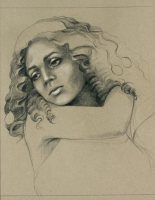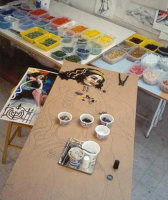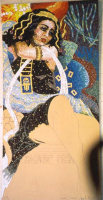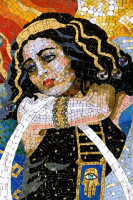75″ x 33″, Venetian vitreous glass, gold tessera, gems, gold leaf on wood panel. Oct 2001 – completed in May 2002.
This piece depicts an unhappy, albeit rich young Esther, whose hands are “tied” when it comes to approaching her husband with such a serious accusation and extraordinary request. Despite all the riches available to her in her new life at the court of King Khashayarsha, (a.k.a. Ahashverosh, Xerxes and Ahasuerus) Esther is a tragic figure in the midst of Persian harem women who aren’t aware that she doesn’t share their cultural roots. As she is sworn to secrecy in regards to her belonging to the Israelite minority group, Esther must pretend otherwise day after day in the King’s harem where she spends most of her time. The songs, dances, music and stories that encompass the concubines’ daily activities must be a sad reminder of her own culture left behind.
The mosaic image of young Esther from the knees down slowly dissolves into a b&w line drawing of bare legs and feet. This symbolizes Esther’s poor origins. Her toes are intertwined with the wrought iron bars, usually part of the ancient architecture of women’s quarters window coverings. The iron bars symbolize women’s status as rich men’s “assets” that need to be protected (oppressed?) against theft or defilation. My interpretation of her proposes a question. As the design of the iron bars includes a stylized menorah… could this symbol become also her prison?







